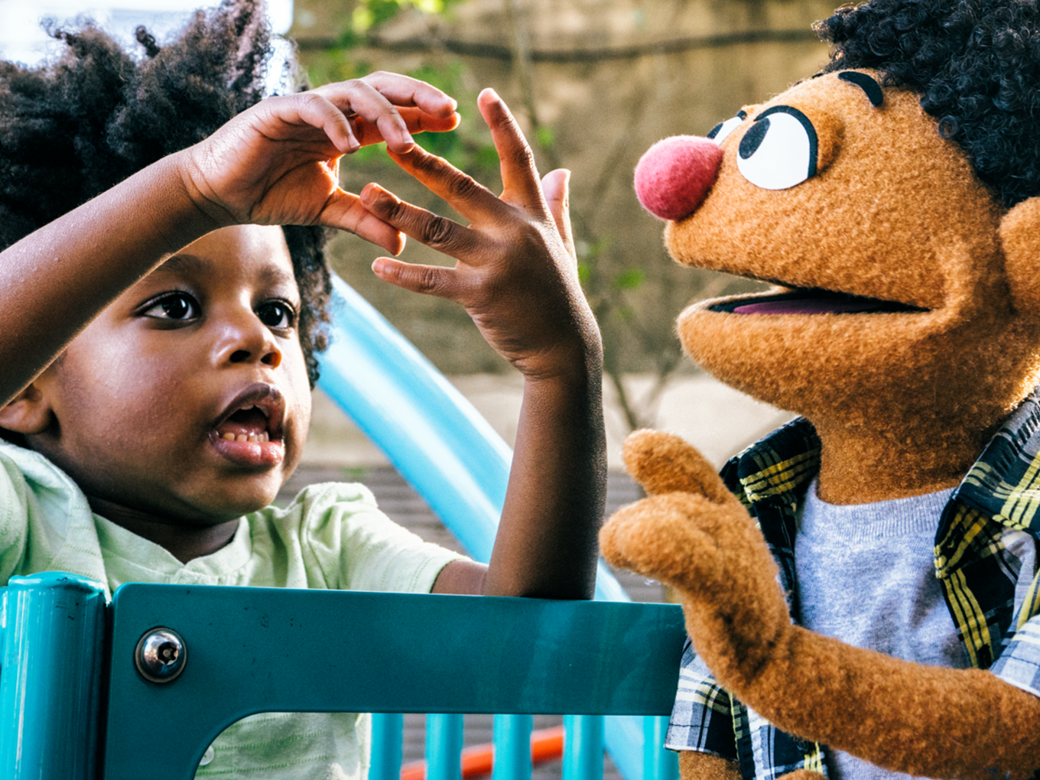
Parenting

Be a life-long learner! Explore these professional development resources created for all caring adults who help children thrive.

Sesame Workshop South Africa’s Literacy Webinar examined language barriers that create significant learning gaps in other subjects such as mathematics and science. Globally, students who spoke the language of instruction at home were more likely to achieve maximum proficiency in these subjects, while those who did not often fell behind.
We also found that home Language during the Foundation Phase influences Grade 4 outcomes, specifically how Grade 3 Home Language proficiency predicts Grade 4 repetition rates and affects performance in English First Additional Language. Watch the webinar below, held on the 11th of June 2025.
Topic:
Detailed Goal: Positive Social Skills
Audience: Parent / Caregiver
Written by Samantha Berger Share Grover’s celebration of the body part that that makes everyone an amazing individual! After reading, consider: Remembering and recounting all the amazing facts Grover shares about our brains. Talking about ways we can build our brain power—reading, coloring, moving, talking, listening, playing games, and so on. Explaining that the brain is hungry! It’s the first of the body’s organs to absorb nutrients. Some foods that benefit kids’ brain function: salmon (for omega-3 fatty acids), eggs, peanut butter, whole grains, oats, berries, beans, colourful vegetables (think spinach!).
Topic: Play Cards
Detailed Goal: Parenting
Audience: Parent / Caregiver
Children love to play—and as they do, we can help them explore the world around them and practice important skills.
Topic: Growing and Learning Through Play
Detailed Goal: Parenting
Audience: Parent / Caregiver
Children love to play—and as they do, we can help them explore the world around them and practice important skills. Children are wired to play—you can see this from very early in a child’s life. Even at just a few months old, babies’ curiosity about the world around them is evident when they reach for objects, mimic facial expressions and sounds, and giggle and laugh. Their growing brains crave these playful connections, which help to build a sense of safety and trust. That play-based, curiosity-driven way of moving through the world continues as children get older. Playful experiences serve as a vehicle for children’s growth and development. Through play, children learn to regulate their feelings, adopt new perspectives, think flexibly, solve problems, and much more. That’s why it is so important for the grown-ups in young children’s lives to support, encourage, and model many ways to play. Consider these ideas to facilitate children’s play: Tower talk. Playing together helps children consider new ways of doing things, uncover different perspectives, and build cooperation skills. Together, build a tower (out of blocks, food storage containers, paper cups, or whatever you have on hand) and taking turns adding to the stack. With each turn, share something about yourself. As the tower gets taller, your relationship will grow, too! Mix it up. Add play into your daily tasks by inviting children to help you think of different ways to get things done. Instead of folding towels, you might roll them. Instead of walking to get the mail, you might hop like a bunny! What other ordinary chores can you do in a creative, playful way? Imagine it! Store-bought toys can be special, but don’t underestimate the playful power of objects you might have laying around the house. With just a little imagination, bowls turned upside-down become a drum set. Couch cushions become castle walls. And that box is definitely a spooky cave! Push play. When children (or grown-ups!) have big feelings, such as frustration or sadness, a playful outlook can make a big difference. Together with children, draw a circle on a piece of paper. In the circle, draw two lines (like a pause button) and an arrow (like a “play” button). When things start to feel serious or stressful, “push” the button to “pause.” Take a deep breath and think of a way to approach the situation playfully. Now pretend to press the “play” button. Can you turn this stressful moment into a game? Play…All Grown Up As you know, children look to grown-ups for guidance for almost everything, including play. It can be difficult at times for us to tap into our playful side, but it’s worth the effort! Keep these things in mind: Rediscover it. We can model play by rediscovering it for ourselves. Play may look a little different as a grown-up, and that’s okay. The key is to find—and regularly do—things that bring you joy. Consider joining a recreational sports team, book club, or video game league. Fill pages of a journal with short stories, or a canvas with colorful paint. Schedule it. While spontaneous play is wonderful, with our busy schedules, being intentional can help us make play a regular part of our lives. Can you set aside time for play each week? Can you schedule it into your daily routine? You might try to choose a time each day in which you need a natural pick-me-up, such as in the middle of the afternoon or first thing in the morning. Include the children in your care, but remember that you can play without children, too! Savor it. In the video above, Zoraima Rosario-Rolón, provider to FFN caregivers, explains how the “lightbulb moments” that children often experience during play can also be a beautiful gift for caregivers to receive. As you nurture a playful attitude in yourself and in your relationships with children, you can be confident that you truly are making a positive difference. You’re setting the stage for children’s success in life!
Topic: Mindful Caregivers
Detailed Goal: Parent / Caregiver
Audience: Parents
Practicing mindfulness is a great way to slow down and reset. Caring for children is full of joy and excitement and it can also be a lot of hard work. When our days are busy, full of learning and routines, we can sometimes forget to take a moment for ourselves as caregivers. One great way to do this is through the practice of mindfulness. Mindfulness means really slowing down and paying attention to the world around you. The practice can help children and caregivers feel happier, healthier, and more in control. If you begin to feel yourself getting overwhelmed, perhaps during a difficult transition between daily activities or after a child’s challenging behavior, try one of these strategies to help yourself reset. You might invite children in your care to join you! Belly breathing: Focus on your breath for a few moments. Take slow, deep breaths, in through your nose, and out through your mouth, pretending as if you are smelling a rose, and then blowing out a candle. Noticing: Notice what you see around you. What do you hear? What do you smell? What sensations do you feel in your body? Using your senses, find one thing in your environment and focus on it for a few moments. Stretching: Try some gentle stretching exercises, using different parts of your body. Pay attention to which muscles and joints could use a little extra care. Gratitude: Take a few breaths and think about or say out loud three things you’re feeling grateful for this week.
Topic: Tracking Child Development: A Caregiver’s Guide
Detailed Goal: Positive Social Skills
Audience: Parent / Caregiver
Keeping track of milestones and going to routine screenings helps children stay healthy and thriving. As a caregiver, you are part of an important team that helps make sure the children in your care are healthy, learning, and growing. One of the key ways to do this is through keeping track of how children are developing. Milestones are things children are able to do by a given age—like talking, walking, and playing. All children are different, and every child reaches their milestones on a slightly different schedule. Noticing, watching, and tracking a child’s milestones for their age helps give parents and healthcare providers a better understanding of how a child is learning and growing (and can be a great way to remember and celebrate special moments)! Developmental screenings help make sure children are healthy and growing. These are done by professionals, like doctors or other healthcare providers, to evaluate a child’s development by asking questions and watching children’s behavior and skills. The American Academy of Pediatrics recommends developmental screening for all children during regular well-child visits at the ages of 9 months, 18 months, and 30 months. They may look at or ask about things like: Language and Communication (responding or reacting to others, saying a certain number of words, etc.) Learning and Thinking (following directions, problem-solving, etc.) Social (smiling at others, playing next to other children, etc.) Movement (crawling, walking, running, jumping, etc.) It’s important to remember (and remind parents and other caregivers) that developmental screenings are meant to help identify children who may need extra support, not as a test to pass. You can play a role by sharing this important information with them. For tips on talking with parents and other caregivers about a child’s development, check out this article. Caring for children is a team effort, and together, we can help make sure that children are healthy and thriving.
Topic: Eating Well on a Budget
Detailed Goal: Parenting
Audience: Parent / Caregiver
Save your family money while eating healthy and delicious meals. Try these tips: Choose low-cost sources of protein. Dried beans, peas, lentils, canned fish, eggs, and peanut butter are healthy, inexpensive sources of protein. Buy fruits and vegetables that are in season. Most fruits and vegetables are available all year, but some cost less when they are in season. For example, in late summer tomatoes drop in price; in the fall apples are in season. Ask your grocer or look online. Check out farmers markets. Farmers markets offer seasonal fruits and vegetables direct from farmers, and many accept SNAP cards or WIC vouchers (stop at the info booth to find out). Buy in bulk. You may save money by buying large quantities or stocking up on sale items. For example, bulk oats are much less expensive than instant oatmeal and cook up almost as quickly. Be in the know. Find out when stores publish weekly flyers or announce sale items. Check with clerks or store managers to ask about upcoming sales. Check unit prices. Most stores print a price-per-pound or price-per-unit cost in small print below the larger item price. Compare brands to find out which healthy option offers the best overall price for your dollar. Stick to a weekly meal plan. Together as a family, make a plan for the week’s meals and try to use ingredients for more than one meal. For example, a whole grilled or roast chicken can last for a few meals.
Topic: 5 Healthy, Easy, Kid-Pleasing Recipes
Detailed Goal: Parenting
Audience: Parent / Caregiver
Print and try these quick, nutritious snacks and meals made with inexpensive ingredients. Little ones can help with many of the steps, such as measuring, stirring, and mashing. Bert & Ernie’s Saturday Morning Pancakes If you don’t have whole-wheat flour, 1 cup of just white flour will work! 1 Tbsp oil 1x 170 grams container plain fat-free yogurt 2 eggs ¼ tsp. cinnamon 1 tsp. baking soda 2/3 cup whole wheat flour 1/3 cup white flour 2 bananas a handful of blueberries or strawberries (optional) Mix dry ingredients, then stir in yogurt and eggs. Mash bananas and add, stir till smooth. Stir in extra fruit, if desired. Fry in oiled pan over medium heat until bubbles appear at edges, then flip. Grover’s Adorable Little Lentils Lentils are a cost-effective source of protein for growing bodies, and lentil soup can be a comforting one-pot meal. 2 carrots, chopped 2 celery ribs, chopped 1 medium onion, chopped 2 cloves garlic, minced 2 Tbsp oil Pinches of salt and pepper, to taste 2 ¼ cups dried lentils 1x 411 grams can of diced tomatoes 11 cups water or broth 2 cups dry pasta (a small shape such as orzo or ditalini) 10 cups fresh spinach (or 2 cups frozen) Sautee vegetables and garlic over medium heat until soft (5-8 minutes). Add tomatoes and simmer 8 minutes. Add salt, pepper, water or broth, and lentils, bring to boil, then simmer 30 minutes. Add pasta and spinach; simmer another 8 minutes. Rosita’s Mango Salsa Frozen fruit is as delicious and nutritious as fresh—and is usually less expensive. 2 cups diced mango (fresh or frozen) ¼ cup chopped onion 1/3 cup diced bell peppers 3 Tbsp. chopped jalapeño pepper (optional) 1 garlic clove, minced Juice from 2 limes Combine all ingredients and enjoy! Abby’s Hummus Here’s a filling, protein-packed snack. 1x 425 grams can chickpeas 1/3 cup water 1/3 cup lemon juice 1 clove garlic, minced ½ cup tahini pinches of salt and pepper 1 sprig parsley (or a large pinch of dried parsley) Put all ingredients in blender and blend at high speed until smooth. Offer vegetable slices or whole-wheat crackers to dip in. Cookie Monster’s Carrot Bites You can make cookies healthier! ½ cup whole wheat flour (it’s healthier, but white will still work) ½ cup white flour ¼ tsp salt 1 tsp baking soda 1 tsp baking powder 6 Tbsp oil 1 cup brown sugar 1 egg ½ cup raisins ¾ cup grated carrots ½ cup chopped walnuts (optional, check for nut allergies) ½ cup oats Mix together the first five ingredients, then add the rest. Place dough on cookie sheet by rounded teaspoonfuls. Bake at 180°C for 15 minutes.
Topic: Healthy Choices in Fast Food Restaurants
Detailed Goal: Parenting
Audience: Parent / Caregiver
An article about healthy choices in fast food restaurants. Even on the go and on a budget, you can help your child get the nutrition they need: Choose water over soda, juices, or shakes. Choose grilled or baked instead of fried or breaded (for instance, a baked potato over french fries). Look for fruits, vegetables, and salads. Skip the cheese and go lighter on mayonnaise and sweetened sauces like ketchup or barbecue sauce. Be aware of large portions (children need less than adults) and share the meal or bring a container to save it for later. Look for healthy desserts such as sliced fruit.
Topic: Eating Well
Detailed Goal: Nutrition
Audience: Parents
Tips and ideas for parents on feeding the family on a budget, plus activities for kids. Print and share any or all of these pages with your child (if you don’t have access to a printer, you might look together on screen and talk about what you see). Sit side by side with crayons, coloured pencils, or markers. Read the directions together, and help children complete the activities. You can do the whole book at once or just print out individual pages. Check out the pages that are meant just for adults and consider the tips and ideas for stretching your grocery dollars and offering your family healthy food. As you help children complete the pages, there’s an opportunity to discuss any challenges you’re facing in getting enough healthy food. If you’re having these difficult conversations, here are some things you might say: While we may not always have the food we want, I’m working hard to make sure our family has the healthy food we need. We won’t always be having this problem. There are other grown-ups who know how to help us. Working through tough times together is going to help us grow stronger as a family. We will keep finding new ways to stay healthy together. You are an important part of our family’s healthy team. We can plan meals together, shop for healthy food, and work together to prepare it.
Topic: Special time
Detailed Goal: Make a "together time" calendar
Audience: Parent / Caregiver
Elmo and his family create a "together time" calendar.
Topic: Positive Parenting
Detailed Goal: Understanding behaviour as communication
Audience: Parent / Caregiver
Even parents on Takalani Sesame need to practice their resilience in parenting. We follow their steps to work through challenges.
Topic: Stigma and Kindness
Detailed Goal: Stay connected safely
Audience: Parent / Caregiver
Elmo and his family talk about how to stay connected safely
Topic: Positive Parenting
Detailed Goal: Practice positive parenting
Audience: Parent / Caregiver
Parenting is like doing a puzzle, you have to keep putting pieces together, and the pieces change with feelings, developmental growth, and big events.
Topic: Stress
Detailed Goal: Reset a fun activity when stressed
Audience: Parent / Caregiver
Build a "Positive Ideas Jar" with your child. Brainstorm feel-better strategies, write them on pieces of paper, and put them in a jar.
Topic: Whole family solutions
Detailed Goal: Recognize your circle of care
Audience: Parent / Caregiver
In your neighbourhood, who are the people that you have helped and have helped you during these times? Think of ways you and your family can do the same!
Topic: Fear
Detailed Goal: Observe fear in children's play
Audience: Parent / Caregiver
Children express their feelings as they play. Observe your child at play and notice the opportunities to talk about feelings.
Topic: Big Feelings
Detailed Goal: Recognise big feelings
Audience: Parent / Caregiver
Big feelings can be noticeable in your child’s body and behaviour patterns in different ways.
Topic: Environment and Health
Detailed Goal: Taking care of oneself
Audience: Parent / Caregiver
Uncertainty can be stressful for both caregivers and their children. This infographic provides caregivers with tips on how to facilitate calm and positive interactions and conversations with their children. File size: 5 MB
Topic: Environment and Health
Detailed Goal: Taking care of oneself
Audience: Parent / Caregiver
Taking care of ourselves is taking care of our families. This infographic provides tips on how you can take care of everyone in your family, including you! File size: 3 MB